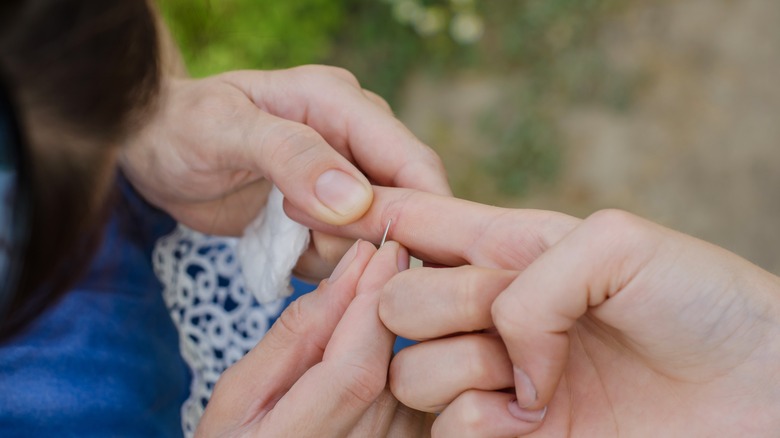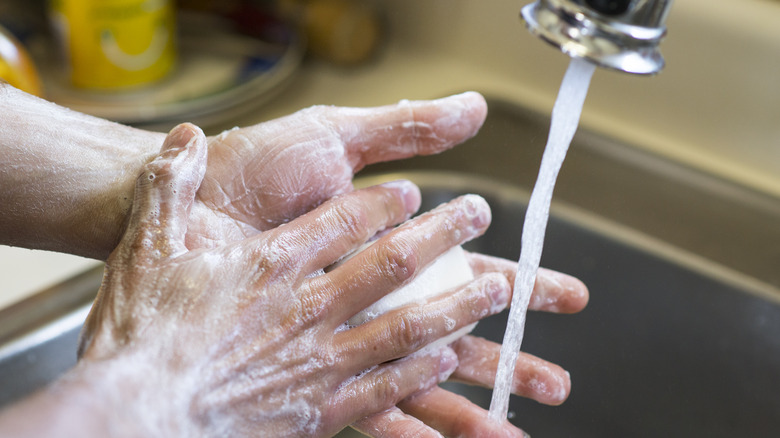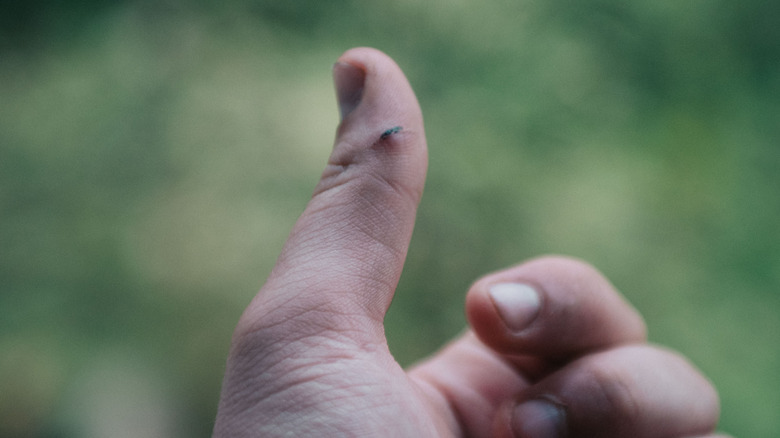The Fruit Hack You'll Want To Know For Removing Splinters When Gardening
Yes, gardening is great for the body, mind, and soul, but it is also an activity that is rife with small injuries. Cue splinters, those irritating wood pieces, thorns, glass shards, tiny bits of plastic, or metal that somehow find their way into your skin when you're busy tending to your flower beds. In fact, it's not just gardening that is a prime pastime for splinters. You can get them from doing housework, too.
Once you have one, you're in for some pain. Despite their tiny size, splinters can cause quite a bit of discomfort. Understandably, your first thought would be to try and get them out. While reaching for a pair of tweezers is the most well-known method if you get a splinter, there's another hack using a fruit — a banana peel, to be specific (via Healthline).
Simply place a small piece (enough to cover the area) white-side down on your skin over the splinter. Cover it with tape or a bandage and leave it like that for 30 minutes or even overnight. Apparently, the enzymes in the fruit work by adding moisture to the area and coaxing the splinter out. Once the skin is swollen from the moisture, you'd be better able to pluck the splinter out easily, according to board-certified pediatrician Dr. Steve Silvestro. You can use a tweezer to do this.
Don't forget your splinter removal basics, though (even with the fruit hack)
Before trying the fruit hack to remove the object, however, it is prudent to cleanse the skin (and around the area) where the splinter is embedded. You do this to prevent the spread of any germs and the resulting infection. Simple soap and water would do. Once you've patted the skin dry, use a magnifying glass (if needed) to see the exact location of the foreign object, per the American Academy of Dermatology Association. This is also useful to note the direction in which the splinter entered your skin, which will invariably help when you're attempting to remove it.
Per Dr. Steve Silvestro, it's interesting to note what happens to your body when you get a splinter. "The truth is that many splinters can be left in place. Over several days, new skin will push up, forcing the splinter out. The body may also start breaking the splinter down, essentially causing it to disintegrate over time," he explained. Of course, this doesn't mean the "ignore and not think about it" method works every time.
When you should be worried about a splinter
While most splinters won't require a trip to the emergency room, the same cannot be said for more serious cases. If you have doubts about your ability to remove it safely, or if you tried and there's still some of it left in your skin, there's no harm in getting professional help.
The location of the splinter might also make it easier or harder for you to extract it. For example, something wedged under your fingernail or toenail (ouch) could be problematic to tackle on your own. The size of the splinter and how deep it is in your skin also matter.
It is important to understand that even though your body is programmed to reject anything foreign and will very likely do so without help from you, a splinter is still a foreign object, and that means it's full of germs. If you notice an infection — redness, swelling, or pus – around the area, get yourself to the hospital immediately. Fruit hack or not, it is important to know when to start worrying about a splinter. Septicaemia or blood poisoning could occur if a splinter goes untreated (via ABC Health). Finally, protect yourself when you're gardening by wearing slippers, gloves, and other similar gear. That way, you can enjoy your favorite hobby with little worry of getting wood pieces stuck in your skin.



